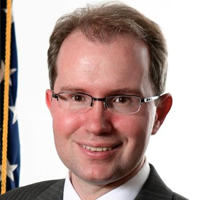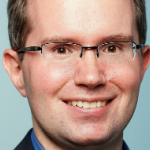The term “Internet of Things” was coined less than 10 years ago, yet its growth has been staggering. Every year since 2013 has been dubbed the “year of IoT.” In 2016, Gartner predicted there would be an average 5.5 million new things connected every day. And various forecasts predict anywhere from 25 to 50 billion or more network devices on the face of the planet by 2020. For context, in 2015, there were approximately 14 billion network devices, and in 2013, just seven billion.
With all these connected things come data – zettabytes upon zettabytes of data – with all estimates pointing to the amount of data on the planet doubling every two years. By 2022, it’s estimated there will be 96 zettabytes, or 96 billion terabytes, of data on the planet. To put that in context, the Library of Congress’ holdings are equal to just 10 terabytes.
As Dr. David Bray, CIO of the U.S. Federal Communications Commission, is fond of saying, “This is not linear change, this is exponential change.”
How to lead in these exponential times is the focus of Bray’s talk today at SXSWedu Conference, an event for those passionate about the future of teaching and learning. As part of the education track, Bray will posit that traditional top-down management techniques will not prepare future leaders to handle the thorny challenges that come with rapid, exponential changes in technology – such as job creation, globalization, automation, and more.
We caught up with Bray for a sneak peek of his SXSW talk and to gain more insight into the characteristics and skills leaders will need in the years ahead.

The Enterprisers Project (TEP): Can you talk about why finding new management techniques for leaders in exponential times is a topic you are passionate about?
 Bray: As background, I joined the bioterrorism preparedness and response program with the U.S. Centers for Disease for Control in late 2000. At the time, there were only about 30 people involved in the program, and I was the sole IT person who also knew biology. The “Agile Manifesto” was released in 2001, and I was a big proponent of agile development vs. waterfall and encouraged the bioterrorism response program to use it. Yet, I was continually told to “get back in my box” and follow non-agile methods. They were used to operating on five-year enterprise architecture plans, waterfall processes, and three-year budget cycles, and the institutional hierarchy did not want to change.
Bray: As background, I joined the bioterrorism preparedness and response program with the U.S. Centers for Disease for Control in late 2000. At the time, there were only about 30 people involved in the program, and I was the sole IT person who also knew biology. The “Agile Manifesto” was released in 2001, and I was a big proponent of agile development vs. waterfall and encouraged the bioterrorism response program to use it. Yet, I was continually told to “get back in my box” and follow non-agile methods. They were used to operating on five-year enterprise architecture plans, waterfall processes, and three-year budget cycles, and the institutional hierarchy did not want to change.
I probably would have continued to metaphorically “bang my head” against waterfall development, except September 2001 changed a lot of things. I had been scheduled to give an interagency briefing regarding what we would do technology-wise if an actual bioterrorism event were to happen. That day was Sept. 11, 2001, at 9 a.m. – I never got a chance to give that briefing because the world changed at 8:34 a.m.
For the next three weeks, we responded to the tragic events of 9/11 and accelerated delivery of a minimum viable product set of tools that could allow for web-based reporting of lab results associated with bioterrorism response. We “stood down” from heightened alert on Oct. 1, and I gave my originally scheduled briefing to the FBI and CIA on Oct. 3. The first case of anthrax showed up 24 hours later in Florida. As a result of agile development, we were able to handle more than a million environmental test reports from public health labs through the web. Had we not created that capability in such a short timeframe, those lab results would have had to be delivered through faxes or telephone calls.
During those turbulent days and weeks, I saw many well-meaning people who did not collaborate well. After watching these behaviors, I concluded that, in many cases, the lack of positive collaboration wasn’t directly their fault. They were smart and well-intentioned. But they had been trained to manage via a top-down and extremely turf-conscious approach.
In fact, the original U.S. founders intended for there to be checks and balances, since they had fought a revolution against a king and wanted, per Federalist Papers No. 51, for “ambition to counter ambition.” These checks and balances prevented any one person from having too much power – yet they also consequentially discouraged any fruitful horizontal collaborations.
Our modern challenge is that the world is changing at an accelerating rate. While we need checks and balances, we also need ways that aren’t turf-conscious or impede collaboration across different teams. We need people who can work horizontally, collaboratively, and in an agile fashion to best respond to disruptive events – which are happening at an increasing rate, especially in the areas of technology and our increasingly connected societies.
Do these three things well
TEP: What are the new techniques that bottom-up leaders need to be successful in times of exponential change?
Bray: Leaders will need to be able to do three things well: (1) foster and champion diversity, (2) empower the edge, and (3) champion ecosystem approaches.
When I say diversity, I don’t mean just diversity of backgrounds – where people came from, etc – though that also is important. I mean cognitive and experience-based diversity, people who think differently than others because of their life experiences and training. It’s also important for leaders to establish shared goals upfront, or else diversity may lead to fragmentation and disjointed endeavors.
Diversity matters because it’s been proven in repeat experiments if we have a group of people who are diverse in their knowledge backgrounds, to include even “naïve participants,” the group will be far more successful than a group of people who are all experts in one specific topic. This happens because when we become an expert, we are trained to see the world in a certain way, and that can create blinders to different and new perspectives. This is why cognitive and experience-based diversity is so important – it helps remove “blind spots” that we each have as individuals.
Empowering the edge is the idea that bottom-up is the ideal managerial approach in a rapidly changing world. The edge has many more eyes and ears than the top of an organization; they’re able to spot and sense changes specific to their work or mission context faster.
To integrate what the empowered edge senses with the rest of the organization, as leaders we have to foster positive change agents. This includes giving people autonomy, providing people with measurable progress, and giving people an important, meaningful mission to tackle. When leaders provide all three, people will feel connected to their work, feel they are contributing to something that matters, and as a result, they will identify and solve challenges much faster than in any top-down approach and response.
Finally, championing ecosystem approaches requires that we practice systems thinking. Systems thinking means we don’t explicitly direct or tell the “ants where to go.” Bottom-up leaders sprinkle sugar in certain places, noxious chemicals in others, and eventually, the ants figure out where to go. Increasingly, in exponential times, we will each have to work horizontally with teams we have no direct control over. And so the questions become: How can leaders shape the incentives, the shared narrative, and the perceived values certain outcomes for everyone involved? How do we encourage people to be creative problems solvers no matter what the problem is?
TEP: Why are these three attributes of leadership so important?
Bray: No one leader is going to be able to solve all the challenges that these exponential times will bring. In a rapidly changing world, if all we do is incrementally keep up with the challenges coming at us, we will still fall behind at an accelerating pace. We as leaders need to step outside of expectations and encourage our teams to do so as well.
Throughout history, there have been examples of leaders who have been undone by their own support base because they hadn’t properly managed the friction of stepping outside of expectations. In an exponential time, these three strategies will keep teams engaged, organizations resilient and relevant in a rapidly changing world, and help ensure meaningful results are delivered in our exponential era.
A vow to keep you focused
TEP: Do you have any advice or guidance for leaders who want to embody some of these characteristics?
Bray: Feeling overwhelmed by the demands of exponential change is typical, yet we all must start somewhere – the most important question of any leader is where you choose to focus your attention. I’ve seen a lot of attempts at leader-driven organizational changes that are, quite frankly, shiny and superficial. They create a lot of heat and light, yet they don’t move the organization forward in meaningful ways. Often shiny or superficial efforts create the unintended consequence of “change fatigue” that makes it doubly hard to make changes in the future.
So as a first step, make a vow to focus on lasting, meaningful change that is within your scope of influence. If you are truly sincere about being a leader in exponential times, you have to commit to do things of substance that will actually move the ball forward for your organization. With that focus, you can begin to look for opportunities to solve problems with your scope. These can be reoccurring problems that no one else seems to be tackling or a major unaddressed gap in the organization’s capabilities.
Once you spot a problem worth solving, evaluate it. Listen and look at it from different angles. Come up with different hypotheses for both why it is happening and why certain organizational remedies might work. Test both your hypotheses and proposed remedies to solve the problem by sharing them with your peers, with your boss, and with a diverse set of people with varying backgrounds. Do others also agree with your assessment of the situation and solution? Asking these questions and bringing possible solutions, not just problems, starts you on the journey of empowering the edge of your organization as well as cultivating an ecosystem of creative problem solvers. Long-term success depends on finding ways to help everyone involved feel a sense of ownership in the outcomes and solutions to the problems you are looking to solve.
Change never happens with any one individual. Change that matters – and change that lasts – happen with a network of diverse individuals who are united in their passion for the mission at hand.
Editor’s note: If you would like to see a video of Bray’s SXSW talk on Leadership in Exponential Times, an earlier version is available here.









Comments
wise leadership from dr. bray on how to lead the way. especially liked the recognized news for positive change in a turbulent world. thank you for sharing.
Great Article!